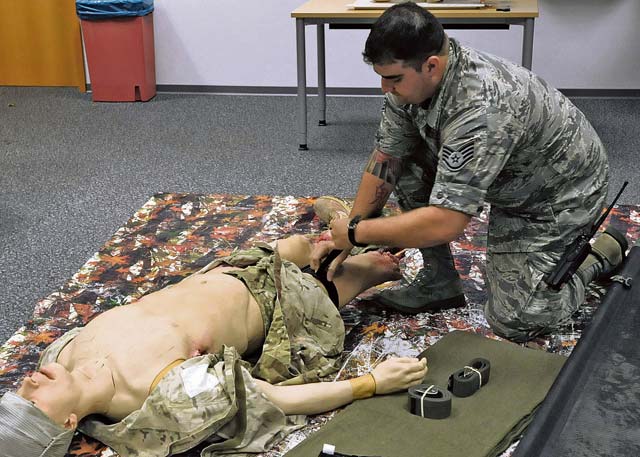
Self-aid and buddy care are intended to provide basic first-aid training to preserve life, limb and eyesight. The training is separated into two portions: computer-based and hands-on.
While the CBT provides updated information on first-aid care concepts and the individual first-aid kit components, the hands-on training is an instructor-led format that emphasizes skills performance.
“Anyone can sit there and read from a slide, but it takes a different approach for some Airmen who are physical learners,” said Tech. Sgt. Jacob See, 86th Security Forces Squadron security forces instructor. “You can explain the process to them, and once you show them that process, the individual has that aha moment where it finally makes sense.”
See and approximately 40 other members from the 86th Airlift Wing, 435th Air Ground Operations Wing, 521st Air Mobility Operations Wing and 3rd Air Force are certified to teach the SABC hands-on training.
“The reason to have instructors is just as important as the reason we teach SABC,” said Master Sgt. Robbin Robertson, 86th AW SABC adviser. “To ensure members are able to help injured personnel in medical emergencies. Instructors provide the framework for giving quality first aid to increase the chance of survival for a fellow Airman or themselves in the event of an injury.”
In order to provide that framework, instructors must first have the foundation themselves. To become instructors, Airmen must complete the SABC instructor course taught by the SABC adviser. Robertson teaches the SABC instructor course every other month.
During the two-day course, members must actively participate in class discussion, a field-based scenario and be evaluated instructing an actual SABC course.
“The first day is instruction where we go over self-aid and buddy care,” Robertson said. “What is it? How (do you) teach it, especially in laymen’s terms for someone who does not do patient care at all? The second day starts in the field, where we practice a scenario in which you would have to give SABC. Then, you have to teach the class you were just in.”
Each student-instructor takes turns teaching a portion of the class to evaluate their information retention. If students are deemed as “not proficient,” they can choose to go through the remedial course, where they can get the hands-on instruction again.
Airmen of any rank can be an SABC instructor. In addition to the requirements set in the Air Force Instruction for SABC training, Robertson only instructs potential instructors who have completed their career development courses and upgrade training.
“It’s important to note that SABC is not just for medical personnel,” Robertson said. “It’s for every (Air Force Specialty Code). Every Airman — big ‘A’ — needs to know the basics of how to save a life, limb or eyesight.”
Once certified, instructors are required to teach a minimum of three classes every 12 months, with classes that cannot exceed a student to teacher ratio of 20-to-1.
“I instruct classes about once a month,” See said. “I’m also the Selectively Trained and Ready program manager. All of our first-term Airmen that come to Ramstein are entered into an augmentee program. This is one of the prerequisites we teach for anyone who is not deemed a first responder.”
See and Robertson agree it’s imperative to teach SABC, because accidents are not limited to on base or downrange.
“You never know when something will happen — peacetime or wartime,” Robertson said. “You need to know the basics, and instructors help get that knowledge disseminated.”
For more information about becoming an SABC instructor, contact your unit training manager or unit deployment manager or email 86aw.sabcadvisor@us.af.mil.


